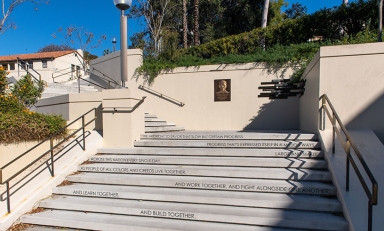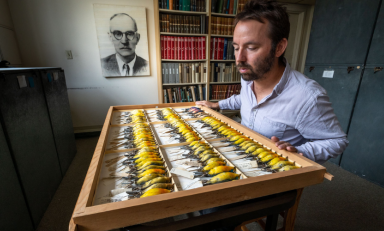Occidental College has partnered with Outpost for Contemporary Art, a nonprofit arts organization in Highland Park, to bring South American artists to the College to teach students, give public lectures, and create interdisciplinary public art projects connected to Los Angeles.
Throughout this academic year, the artists will live and work on the Occidental campus in residencies of four to seven weeks' duration. In exchange, the artists will create art that provides learning and collaboration opportunities for students, faculty, and the public in Los Angeles.
"The partnership is part of Occidental's mission to extend the College into the community and, likewise, to bring the arts community onto campus," said art history and visual arts professor Louise Yuhas.
The first artists, two members of the Sao Paulo, Brazil-based arts collective Grupo Bijari, will be on campus from Oct. 23 to Nov. 21. The artists will give a talk about their work at 5:30 p.m. on Monday, Nov. 8, in Occidental's Johnson Hall, room 200. In addition, Grupo Bijari will participate in an urban and environmental policy course that focuses on immigration experiences, as well as a printmaking class.
Grupo Bijari will also create a project called "America Love Me." The artists will work with 20 Los Angeles teenagers to create an art installation about the students' immigration and education experiences. The installation will include photography, printing, drawing, and writing and will be displayed at a public reception on Friday, Nov. 19 at Outpost for Contemporary Art, located at 1268 N. Avenue 50, Los Angeles. A digital version of "America Love Me" will also be featured on a blog, www.americaloveme/outpost-art.org.
The partnership stems from an informal relationship going back four years with studio art professor Mary Beth Heffernan, said Julie Deamer, Outpost's director. In 2006, Oxy senior studio art majors helped to organize and support art exhibitions and performances during an Outpost program in which Mexican, Canadian, and American artists explored the theme of "fair trade."
"Mary Beth was the catalyst," Deamer said. "What started as an ad hoc relationship between Outpost and one faculty member has grown into a collaboration that adds depth to both institutions' offerings."
This latest collaboration between Occidental and Outpost is natural, as both share a commitment to social justice and bridging cultures through intellectual and creative means, Heffernan said. She hopes that by bringing these South American artists to campus, students and the public will discover that art can be participatory and community-based, not merely isolated physical objects to be displayed in museums.
"Outpost and Oxy provide a type of programming that is simply not available at most other art institutions in the city," Heffernan added. "This is another model of art. This is art-as-action, relationships and community."
The other artists in the 2010-2011 Occidental-Outpost international residency partnership are Brazilian composer and theater director Octávio Camargo and the Argentinean arts and environmental organization Ala Plástica.
Camargo, who will be in residence from Jan. 14 to March 4, 2011, will give lectures on oral tradition and poetry, among other subjects, and lead a College workshop in which students will help him collect, record, and translate works by poets, storytellers and singers into a project about memory and connection between artists in Los Angeles and Brazil. That project will culminate in a final performance at Occidental in early spring.
Ala Plástica, who will be in residence from late March through April 2011, will work with the College's urban and environmental policy, art, and theater departments on their research on the environmental effects of urban oil exploration.
For more information about the Outpost for Contemporary Art, go to www.outpost-art.org.
For more information about Grupo Bijari, go to http://www.bijari.com.br/.
For more information about Octávio Camargo, go to http://www.errantbodies.org/camargo.html.
For more information about Ala Plástica, go to http://www.alaplastica.org.ar/.



